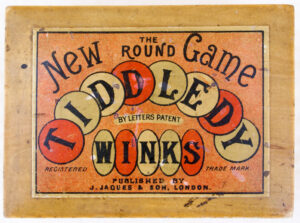Securing the Patent and Trademark for Tiddledy-Winks
Fincher submitted his application for TIDDLEDY-WINKS as a trademark in England on 29 January 1889, and it was approved the week of 6–12 March 1890 (# 85,800). According to The Trade Marks Registration Act, 1875, trademarks expired after 14 years from the registration date. It is not yet known whether this trademark was renewed. In any case, the trademark is no longer in effect.
Fincher’s pivotal role as the owner of the first tiddlywinks patent and thereby as the catalyst in setting the world on fire with tiddlywinks fever and fervor (at least for the next decade) may have been purely an opportunistic or perhaps accidental move on his part. Fincher is not known to have designed or invented any other games. As it turns out, Fincher also patented (in 1890) “Improvements in Sleeve Links”. For the record, sleeve links are also known as cufflinks. Ho hum. And in 1897, Fincher tried to patent a variety of candlesticks, but the application was rejected. Never mind. We will always remember Fincher as the inventor of the unique game of tiddlywinks.
Over eighty patents have been approved for tiddlywinks games since Fincher’s application. In fact, the Cooperative Patent Classification system developed jointly by the U.S. Patent and Trademark Office and the European Patent Office has a subclass expressly for tiddlywinks:
- CPC A63: Sports; Games; Amusements
- CPC A63F: Card, Board, or Roulette Games; Indoor Games Using Small Moving Bodies; Video Games; Games not otherwise provided for
- CPC A63F 9/02: Shooting or hurling games
- CPC A63F 2009/0295: (Tiddley winks type games)
- CPC A63F 9/02: Shooting or hurling games
- CPC A63F: Card, Board, or Roulette Games; Indoor Games Using Small Moving Bodies; Video Games; Games not otherwise provided for
And there have been about 84 patents worldwide to date for tiddlywinks games, including 52 in the US.
No copyrights by Fincher for Tiddledy-Winks have been located.
Getting to Know J. A. Fincher
- Certificate Copy of an Entry of Live Birth for Joseph Assheton Fincher, General Records Office, England
- 1881 England Census, Ancestry.com
- 1888 England patent 85,800
- 1891 England Census, Ancestry.com
- Certificate Copy of an Entry of Death for Joseph Assheton Fincher, General Records Office, England
Navigating Chapters
![[+template:(Tucker Tw ID • [+xmp:title+] — publisher • [+iptc:source+] — title • [+xmp:headline])+]](https://tiddlywinks.org/wp-content/uploads/2023/01/1958-estimate-Rules-of-Tiddlywinks-by-ETwA-SecGen-E-A-Willis-page-1-246x300.jpg)
3 ❖ Tiddlywinks • The Rules
As it turns out, the core concepts of the rules of tiddlywinks have changed little since its invention in 1889. The game pieces that are

6 ❖ John Jaques & Son • Original Publishers of Tiddledy-Winks
It all started in 1795 when a spritely Thomas Jaques established himself as “Thomas Jaques: Manufacturer of Ivory, Hardwoods, Bone, and Tunbridge Ware.” Thomas took
![[+template:(Tucker Tw ID • [+xmp:title+] — publisher • [+iptc:source+] — title • [+xmp:headline])+]](https://tiddlywinks.org/wp-content/uploads/2022/07/1888-11-08-UK-patent-16215-Joseph-Assheton-Fincher-adj-scaled.jpg)
![[+template:(Tucker Tw ID • [+xmp:title+] — publisher • [+iptc:source+] — title • [+xmp:headline])+]](https://tiddlywinks.org/wp-content/uploads/2022/07/1889-05-15-Trade-Marks-Journal-UK-page-476-re-TIDDLEDY-WINKS-IMG_3403-scaled.jpg)
![[+template:(Tucker Tw ID • [+xmp:title+] — publisher • [+iptc:source+] — title • [+xmp:headline])+]](https://tiddlywinks.org/wp-content/uploads/2022/10/1890-03-19-Trade-Marks-Journal-page-262-header.jpg)
![[+template:(Tucker Tw ID • [+xmp:title+] — publisher • [+iptc:source+] — title • [+xmp:headline])+]](https://tiddlywinks.org/wp-content/uploads/2022/10/1890-03-19-Trade-Marks-Journal-page-262-listing-1.jpg)
![[+template:(Tucker Tw ID • [+xmp:title+] — publisher • [+iptc:source+] — title • [+xmp:headline])+]](https://tiddlywinks.org/wp-content/uploads/2022/11/1863-07-21-Birth-certificate-for-Joseph-Assheton-Fincher-at-Longparish-Southampton-England-scaled.jpg)
![[+template:(Tucker Tw ID • [+xmp:title+] — publisher • [+iptc:source+] — title • [+xmp:headline])+]](https://tiddlywinks.org/wp-content/uploads/2022/11/1900-07-14-Death-certificate-for-Joseph-Assheton-Fincher-at-Lambeth-Waterloo-Road-London-England-scaled.jpg)